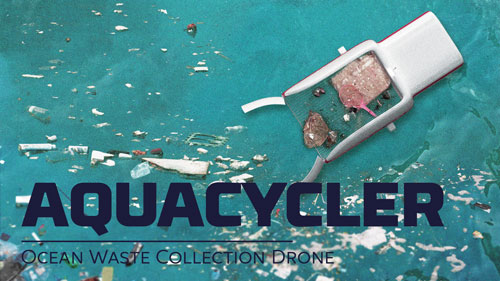Preliminary Research and Documentation
Design and build a AI-based aquatic drone that can be used to clean up floating trash from the surface of rivers, lakes, seas and oceans.
Requirements
The Aquacycler must contain the following parts and components
- Body - A water-proof and aerodynamic body that is designed to collect floating trash and store it.
- Aquacycler has a pair of movable arm-like structures that can collect trash and lead it to the crusher and shredder.
JetHow PropulsionAquacycler Booster System
works
MantaWhether 2in needsautomated navigation mode or when operated remotely, Aquacycler can perform the following actions:
- The arm-like structures skim the surface of water and collect the floating debris and trash.
- The collected trash is pushed towards a
powerful,conveyoryetbelt. - The
jetconveyorpropulsionbeltsystemtransportsthatthe debris to the crusher. The water drains back in to the ocean or sea. - The crusher crushes the debris and the crushed debris falls into the shredder.
- The shredder shreds the crushed debris and stores it.
When Aquacycler returns to land, shredded debris can propel its body weight, weight of batteries, cameras, antenna, lights, etc., and also carry payloads up to 20 kilograms. The propulsion system must be capablerecycled ofor poweringdisposed Manta 2 to reach speeds up to 50 knots (92.6 kmph).
Body
Manta 2 is built using a light material that is waterproof, weather resistant, impact resistant. The body is aerodynamic and can float and dive.
Docking Station
Manta 2 has a docking station has charging pointsoff in thean dockingeco station.friendly The charging points on the docking station and on Manta 2 need to be waterproof.way.
Storage Unit
The storage is designed so that people can easily access the contents. It must be designed to hold medical supplies, emergency diving equipment and a pair of paddles.
Cameras
4 high resolution cameras are placed around the body of Manta 2.
2 cameras in the front, under the headlights. At any point of time, only one camera is used.2 cameras in the rear next to the propellers. At any point of time, only one camera is used.
|
Lights
A set of high powered lighting system to illuminate the sea for better visibility and picture quality. The recommended specifications for the lights are:
SONAR
Proximity Sensors
A proximity sensor detects presence of other objects and/or marine creatures within a given range. These sensors safeguard Manta 2 against crashing into ships, coral reefs, or rocks and boulders under the surface of the water. This has a range of 30.48 centimeters (1 foot) - in all directions.
Salinity Sensor
A salinity sensor measures the salinity of sea water and other solutions. The data is transmitted through cables and over the transmitter to the console on the ship. The salinity sensor must be capable of measuring the entire range of 24-52,000 ppm (parts per million) of sea water.
pH Sensor
A pH sensor measure the pH value of sea water (salinity). The data is transmitted through cables over the transmitter to the console on the ship.
Thermometer (temperature sensor)
The temperature of water changes as we go deeper into the ocean. The thermometer records water temperature at different depths. The data is transmitted through cables and over the antenna/transmitter to the console on the ship.
Antenna/Transmitter
An antenna transmitter is installed on Manta 2 that receives data from the following:
High resolution pictures from the camerasDepth information from the SONAR/depth loggerOcean bed surface data from the proximity sensorSalinity data from the salinity sensorpH values from the pH sensorTemperature
The transmitter transmits this data to the console on the ship for analysis and storage. This data is then parsed and information is uploaded to Manta software application.
Manta software application
Licensing
This project is being developed as an open-source project with the following licensing:
- Software: GPL-3.0 - https://www.gnu.org/licenses/gpl-3.0.en.html
- Hardware, Design & other Intellectual Property: CC-BY-SA-4.0 - https://creativecommons.org/licenses/by-sa/4.0/

